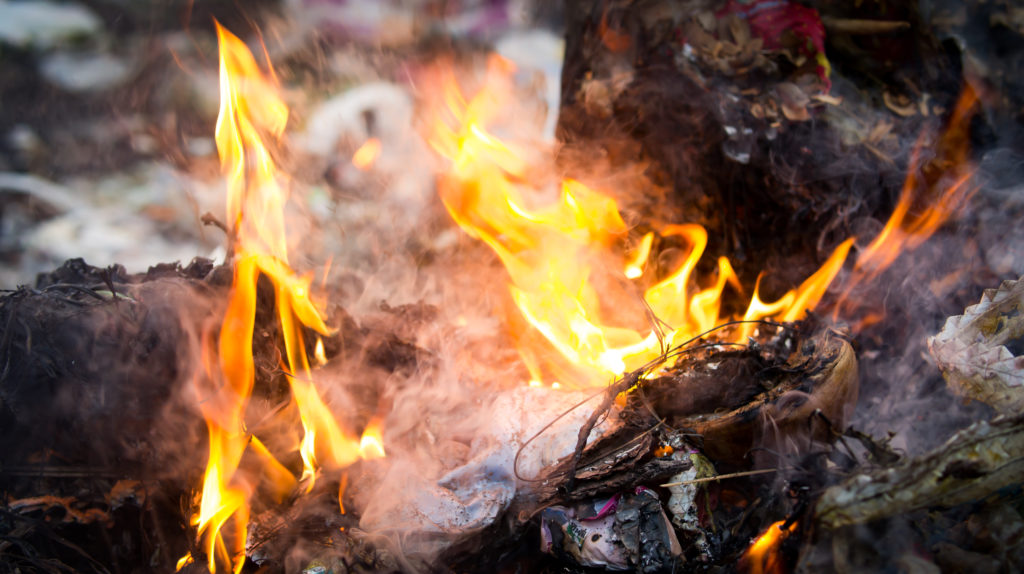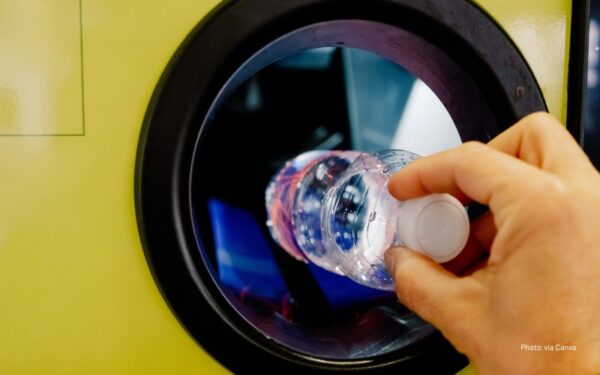
Burning trash harms the health, environment, and economy of many communities. The perceived benefits of refuse incineration simply aren’t worth the risk. Photo: Shutterstock
In previous blogs in our What Is Zero Waste series, we’ve touched on why municipal solid waste, landfills, and trash incinerators are such a problem to our health and our environment. Because trash incineration is especially harmful, we asked Ahmina Maxey, the U.S. and Canada Regional Coordinator with the Global Alliance for Incinerator Alternatives, to tell us more.
Trash incineration is a waste treatment technology that involves burning commercial, residential, and hazardous waste, also known as municipal solid waste. Refuse incineration converts trash like paper, plastics, metals, and food scraps into bottom ash (the heavier ash residue), fly ash (the lighter, more toxic ash, that is more likely to escape the incinerator’s stack), combustion gases, air pollutants, wastewater, wastewater treatment sludge, and heat.
Incinerator companies have done a great job green washing their true impacts on communities by implying that so-called “waste-to-incineration” facilities are good neighbors offering a safe process that eliminates waste, allows for robust recycling programs, and generates renewable energy. Nothing could be further from the truth. The reality is burning trash harms the health, environment, and economy of many communities. The perceived benefits simply aren’t worth the risk.
Trash incinerators pollute nearby communities and diminish the health of the population at large
Burning trash poses considerable risks to the health and environment of nearby communities as well as the broader public. Even the most technologically advanced incinerators release thousands of pollutants that contaminate our air, soil, and water.
What’s more, trash incinerators release more toxic pollution than coal-fired power plants per unit of energy. To make the same amount of energy as a coal power plant, waste incinerators release:
- 28 times as much dioxin (a known carcinogen);
- 5 times as much carbon monoxide (a poisonous gas known as the “silent killer”);
- 3 times as much nitrogen oxides (a gas that aggravates asthmatic conditions and contributes to the production of ozone);
- 6–14 times as much mercury (a toxic, heavy metal that damages the brain, kidneys, and lungs);
- nearly 6 times as much lead (another toxic, heavy metal that damages the brain and kidneys, and causes severe developmental problems in young children, including learning disabilities and impulse control); and,
- 70 percent more sulfur dioxides (toxic gases with a strong odor).
In newer trash incinerators, air pollution control devices such as air filters capture and concentrate some of the pollutants, but they don’t eliminate them. The captured pollutants are simply transferred to other by-products such as ash and wastewater treatment sludge that are then deposited in landfills. Eventually, the ash and sludge are released into the environment when the landfill systems break down.
Air filters also still let many hazardous emissions such as ultra-fine particles (which are unregulated and particularly harmful to health) escape into our air. It is estimated that these kinds of airborne particulates cause the deaths of over 2 million people worldwide each year. Here in the U.S., communities of color, low-income communities, and Indigenous Peoples’ communities are exposed to a disproportionate burden of such toxins.
Trash incinerators do not eliminate the need for a landfill
Trash incinerators are fundamentally a way of treating waste before landfilling it. Although trash incineration is often touted as a landfill alternative, the fact is that 25% of the weight of incoming trash remains as residual ash that still requires landfilling or disposal. This ash contains heavy metals and toxic compounds like dioxins and will be toxic for generations to come. More immediately, these pollutants can leach out into groundwater and rivers.
What’s more, air pollutants such as mercury, dioxin, and other contaminants are also concentrated in fly ash, bottom ash, boiler ash, slag, and wastewater treatment sludge. This remainder is deposited in landfills and will be toxic for generations to come. More immediately, these pollutants can leach out as landfill containment systems break down, posing a more immediate threat to groundwater and rivers.
Ash management is a problem for incinerators, and serious cases of mismanagement have occurred in recent years. In 2011, Massachusetts’s own Wheelabrator paid a record settlement of $7.5 million to the Massachusetts Department of Environmental Protection for failing to properly treat and dispose of toxic ash. It was also cited for releasing 8,000 gallons of contaminated water and ash sludge into local waterways and surrounding wetlands at its three incinerators in Saugus, North Andover, and Millbury.
Trash incinerators are incompatible with recycling and Zero Waste goals
Trash incinerators are competing to process the same materials as recycling and composting programs, but they burn that waste instead. In Massachusetts, 40% of waste that is burned or landfilled are recyclables that are technically banned from those facilities. Another one million tons, or about 18%, are food waste and other organics that could be composted. As long as cities, towns, and businesses are tied up in contracts to burn trash, then reduction, recycling, composting, and other Zero Waste programs are stunted.
Trash incinerators are a massive waste of energy and they contribute to climate change
Proponents of incinerators point to their use as power generators as a plus – with the heat from burning garbage providing electricity that is cleaner than fossil fuel sources. But older incinerators generate electricity at very low efficiency rates of 19-27%, and a recent study from the United Kingdom found that conversion efficiencies of new incineration technologies are even lower.
Conversely, zero waste practices such as recycling and composting could save three to five times the amount of energy produced by burning garbage. When taken together, the amount of energy wasted in the U.S. by not recycling aluminum and steel cans, paper, printed materials, glass, and plastic is equal to the annual output of 15 medium-sized power plants. In other words, if we simply had better practices for recycling, we wouldn’t need as much of the power generated by incinerators in the first place.
What’s more, incinerators emit more carbon dioxide per unit of electricity (2,988 lbs/MWh) than coal-fired power plants (2,249 lbs/MWh). According to the Environmental Protection Agency, “waste-to-energy” incinerators and landfills contribute far higher levels of greenhouse gas emissions and overall energy than following the reduce, reuse, recycle mantra.
High heat “conversion” technologies are no better than incinerating trash
Other incinerators use high heat technologies such as gasification, plasma arc and pyrolysis, sometimes called “conversion” technologies, attempting to convert solid waste into synthetic gas or oils followed by combustion. These incinerators have all of the same downfalls as traditional incinerators. They are expensive to build; polluting; don’t eliminate the need for a landfill; squash reduction, recycling and composting programs; and produce few jobs when compared to Zero Waste programs. Finally, just like traditional incinerators, they are unsustainable and inefficient producers of energy when compared to the energy saved by Zero Waste programs.
So very, very much is wrong with burning trash. Instead of continuing to “feed the beast” and send our trash to outdated, dangerous incinerators, New England should prioritize Zero Waste practices – reducing, recycling, and composting. We can’t keep putting the health of our communities, our climate, and our environment at risk for the sake of our garbage.



